Dynamic Risk Assessment of Landslide Hazard for Large-Scale Photovoltaic Power Plants under Extreme Rainfall Conditions
Abstract
:1. Introduction
2. Study Area of Photovoltaic Power Plants
3. Method
3.1. Landslide Susceptibility Assessment Index System
3.2. Calculation of Factor Weights Using ANP
3.3. Building Fuzzy Bayesian Networks
3.4. Selection of Landslide Hazard Vulnerability Assessment Factors
3.4.1. Economic Vulnerability Factors
3.4.2. Population Vulnerability Factors
3.4.3. Physical Vulnerability Factors
3.5. Calculating Landslide Vulnerability Using AHP
3.6. Determination of Rainfall Thresholds
3.7. Dynamic Assessment Model Based on Coupling Risk Zoning and Rainfall Thresholds
4. Results and Discussion
4.1. Landslide Susceptibility Zoning of Photovoltaic Power Plants
4.2. Landslide Vulnerability Zoning of Photovoltaic Power Plants
4.3. Dynamic Zoning of Photovoltaic Site Risk with Coupled Extreme Rainfall
5. Conclusions
- (1)
- In the evaluation results of landslide disaster susceptibility obtained by using the ANP-FBN combined model, the AUC value of each grade zoning is higher than 88.5%, and the standard deviation is less than 0.01. This shows that the method has good accuracy and robustness and can reduce the negative influence of subjective factors on the evaluation results to a certain extent.
- (2)
- Considering the unique attributes of engineering construction in large photovoltaic power plants, novel quantitative indicators are introduced to assess economic vulnerability, specifically focusing on power generation loss. By integrating the vulnerability of population and material characteristics, a comprehensive and objective assessment index system for assessing the vulnerability of large photovoltaic power plants is constructed in a rational and systematic manner.
- (3)
- During the dynamic assessment of landslide hazards, as the duration of rainfall increases, the percentage of the area of “high and higher” risk zones grows from 15.89% before the rainfall to 40.06% at the end of the rainfall. The areas of “high” and “very high” risk are predominantly concentrated in the central valley and the eastern steep slopes. It is imperative to prioritize landslide prevention and monitoring efforts in these specific areas.
- (4)
- In this study, due to the subjectivity of the AHP method, the assessment results of the vulnerability of photovoltaic sites are easily affected by subjective errors, and there are shortcomings such as using only the rainfall intensity–duration threshold (I–D) as a discriminating criterion for the probability of landslide occurrence. Subsequently, multiple evaluation methods were used with rainfall threshold curves to carry out the dynamic risk assessment of landslides, and we selected the most accurate and reasonable evaluation methods by comparing the evaluation results.
Author Contributions
Funding
Data Availability Statement
Conflicts of Interest
References
- Maletta, R.; Mendicino, G. A methodological approach to assess the territorial vulnerability in terms of people and road characteristics. Georisk Assess. Manag. Risk Eng. Syst. Geohazards 2022, 16, 301–314. [Google Scholar] [CrossRef]
- Zhang, S.; Zhang, L.M. Human vulnerability to quick shallow landslides along road: Fleeing process and modeling. Landslides 2014, 11, 1115–1129. [Google Scholar] [CrossRef]
- Eidsvig, U.M.; McLean, A.; Vangelsten, B.V.; Kalsnes, B.; Ciurean, R.L.; Argyroudis, S.; Winter, M.G.; Mavrouli, O.C.; Fotopoulou, S.; Pitilakis, K. Assessment of socioeconomic vulnerability to landslides using an indicator-based approach: Methodology and case studies. B. Eng. Geol. Environ. 2014, 73, 307–324. [Google Scholar] [CrossRef]
- Hearn, G.J.; Pongpanya, P. Developing a landslide vulnerability assessment for the national road network in Laos. Q. J. Eng. Geol. Hydroge. 2021, 54, qjegh2020-110. [Google Scholar] [CrossRef]
- Chen, X.; Zhang, L.; Chen, L.; Li, X.; Liu, D. Slope stability analysis based on the Coupled Eulerian-Lagrangian finite element method. B. Eng. Geol. Environ. 2019, 78, 4451–4463. [Google Scholar] [CrossRef]
- Wang, H.J.; Xiao, T.; Li, X.Y.; Zhang, L.L.; Zhang, L.M. A novel physically-based model for updating landslide susceptibility. Eng. Geol. 2019, 251, 71–80. [Google Scholar] [CrossRef]
- An, H.; Viet, T.T.; Lee, G.; Kim, Y.; Kim, M.; Noh, S.; Noh, J. Development of time-variant landslide-prediction software considering three-dimensional subsurface unsaturated flow. Environ. Modell. Softw. 2016, 85, 172–183. [Google Scholar] [CrossRef]
- Zhang, K.; Xue, X.; Hong, Y.; Gourley, J.J.; Lu, N.; Wan, Z.; Hong, Z.; Wooten, R. iCRESTRIGRS: A coupled modeling system for cascading flood–landslide disaster forecasting. Hydrol. Earth Syst. Sci. 2016, 20, 5035–5048. [Google Scholar] [CrossRef] [Green Version]
- Shen, P.; Zhang, L.; Chen, H.; Fan, R. EDDA 2.0: Integrated simulation of debris flow initiation and dynamics considering two initiation mechanisms. Geosci. Model Dev. 2018, 11, 2841–2856. [Google Scholar] [CrossRef] [Green Version]
- Chen, H.X.; Zhang, L.M. EDDA 1.0: Integrated simulation of debris flow erosion, deposition and property changes. Geosci. Model Dev. 2015, 8, 829–844. [Google Scholar] [CrossRef] [Green Version]
- Onyelowe, K.C.; Sujatha, E.R.; Aneke, F.I.; Ebid, A.M. Solving geophysical flow problems in Luxembourg: SPH constitutive review. Cogent Eng. 2022, 9, 2122158. [Google Scholar] [CrossRef]
- Mehmood, E.; Rashid, I.; Ahmed, F.; Farooq, K.; Tufail, A.; Ebid, A.M. Hydrogeotechnical Predictive Approach for Rockfall Mountain Hazard Using Elastic Modulus and Peak Shear Stress at Soil–Rock Interface in Dry and Wet Phases at KKH Pakistan. Sustainability 2022, 14, 16740. [Google Scholar] [CrossRef]
- Sharma, S.; Mahajan, A.K. A comparative assessment of information value, frequency ratio and analytical hierarchy process models for landslide susceptibility mapping of a Himalayan watershed, India. Bull. Eng. Geol. Environ. 2018, 78, 2431–2448. [Google Scholar] [CrossRef]
- Chen, W.; Li, W.; Chai, H.; Hou, E.; Li, X.; Ding, X. GIS-based landslide susceptibility mapping using analytical hierarchy process (AHP) and certainty factor (CF) models for the Baozhong region of Baoji City, China. Environ. Earth Sci. 2015, 75, 63. [Google Scholar] [CrossRef]
- Kadi, F.; Yildirim, F.; Saralioglu, E. Risk analysis of forest roads using landslide susceptibility maps and generation of the optimum forest road route: A case study in Macka, Turkey. Geocarto Int. 2021, 36, 1612–1629. [Google Scholar] [CrossRef]
- Chen, W.; Zhang, S. GIS-based comparative study of Bayes network, Hoeffding tree and logistic model tree for landslide susceptibility modeling. Catena 2021, 203, 105344. [Google Scholar] [CrossRef]
- Lee, S.; Lee, M.; Jung, H.; Lee, S. Landslide susceptibility mapping using Naïve Bayes and Bayesian network models in Umyeonsan, Korea. Geocarto Int. 2020, 35, 1665–1679. [Google Scholar] [CrossRef]
- Song, Y.; Gong, J.; Gao, S.; Wang, D.; Cui, T.; Li, Y.; Wei, B. Susceptibility assessment of earthquake-induced landslides using Bayesian network: A case study in Beichuan, China. Comput. Geosci. 2012, 42, 189–199. [Google Scholar] [CrossRef]
- Chen, W.; Pourghasemi, H.R.; Panahi, M.; Kornejady, A.; Wang, J.; Xie, X.; Cao, S. Spatial prediction of landslide susceptibility using an adaptive neuro-fuzzy inference system combined with frequency ratio, generalized additive model, and support vector machine techniques. Geomorphology 2017, 297, 69–85. [Google Scholar] [CrossRef]
- Marjanovi, M.; Kova Evi, M.; Ba Jat, B.; Enílek, V.V. Landslide susceptibility assessment using SVM machine learning algorithm. Eng. Geol. 2011, 123, 225–234. [Google Scholar] [CrossRef]
- Zhou, C.; Yin, K.; Cao, Y.; Ahmed, B.; Li, Y.; Catani, F.; Pourghasemi, H.R. Landslide susceptibility modeling applying machine learning methods: A case study from Longju in the Three Gorges Reservoir area, China. Comput. Geosci. 2018, 112, 23–37. [Google Scholar] [CrossRef] [Green Version]
- Bai, S.; Wang, J.; Lü, G.; Zhou, P.; Hou, S.; Xu, S. GIS-based logistic regression for landslide susceptibility mapping of the Zhongxian segment in the Three Gorges area, China. Geomorphology 2010, 115, 23–31. [Google Scholar] [CrossRef]
- Ayalew, L.; Yamagishi, H. The application of GIS-based logistic regression for landslide susceptibility mapping in the Kakuda-Yahiko Mountains, Central Japan. Geomorphology 2005, 65, 15–31. [Google Scholar] [CrossRef]
- Umar, Z.; Pradhan, B.; Ahmad, A.; Jebur, M.N.; Tehrany, M.S. Earthquake induced landslide susceptibility mapping using an integrated ensemble frequency ratio and logistic regression models in West Sumatera Province, Indonesia. Catena 2014, 118, 124–135. [Google Scholar] [CrossRef]
- Hong, H.; Pourghasemi, H.R.; Pourtaghi, Z.S. Landslide susceptibility assessment in Lianhua County (China): A comparison between a random forest data mining technique and bivariate and multivariate statistical models. Geomorphology 2016, 259, 105–118. [Google Scholar] [CrossRef]
- Chen, W.; Xie, X.; Peng, J.; Shahabi, H.; Hong, H.; Bui, D.T.; Duan, Z.; Li, S.; Zhu, A.X. GIS-based landslide susceptibility evaluation using a novel hybrid integration approach of bivariate statistical based random forest method. Catena Interdiscip. J. Soil Sci. Hydrol.-Geomorphol. Focus. Geoecology Landsc. Evol. 2018, 164, 135–149. [Google Scholar] [CrossRef]
- Kim, J.C.; Lee, S.; Jung, H.S.; Lee, S. Landslide susceptibility mapping using random forest and boosted tree models in Pyeong-Chang, Korea. Geocarto Int. 2018, 33, 1000–1015. [Google Scholar] [CrossRef]
- Pradhan, B.; Lee, S. Landslide susceptibility assessment and factor effect analysis: Backpropagation artificial neural networks and their comparison with frequency ratio and bivariate logistic regression modelling. Environ. Modell. Softw. 2010, 25, 747–759. [Google Scholar] [CrossRef]
- Pradhan, B.; Lee, S. Regional landslide susceptibility analysis using back-propagation neural network model at Cameron Highland, Malaysia. Landslides 2010, 7, 13–30. [Google Scholar] [CrossRef]
- Pradhan, B.; Lee, S.; Buchroithner, M.F. A GIS-based back-propagation neural network model and its cross-application and validation for landslide susceptibility analyses. Comput. Environ. Urban Syst. 2010, 34, 216–235. [Google Scholar] [CrossRef]
- Xu, K.; Guo, Q.; Li, Z.; Xiao, J.; Qin, Y.; Chen, D.; Kong, C. Landslide susceptibility evaluation based on BPNN and GIS: A case of Guojiaba in the Three Gorges Reservoir Area. Int. J. Geogr. Inf. Sci. 2015, 29, 1111–1124. [Google Scholar] [CrossRef]
- Dong, V.D.; Jaafari, A.; Bayat, M.; Gholami, D.M.; Pham, B.T. A spatially explicit deep learning neural network model for the prediction of landslide susceptibility. Catena 2020, 188, 104451. [Google Scholar]
- Lv, L.; Chen, T.; Dou, J.; Plaza, A. A hybrid ensemble-based deep-learning framework for landslide susceptibility mapping. Int. J. Appl. Earth Obs. 2022, 108, 102713. [Google Scholar] [CrossRef]
- Mandal, K.; Saha, S.; Mandal, S. Applying deep learning and benchmark machine learning algorithms for landslide susceptibility modelling in Rorachu river basin of Sikkim Himalaya, India. Geosci. Front. 2021, 12, 17. [Google Scholar] [CrossRef]
- Sameen, M.I.; Pradhan, B.; Lee, S. Application of convolutional neural networks featuring Bayesian optimization for landslide susceptibility assessment. Catena 2020, 186, 104249. [Google Scholar] [CrossRef]
- Ebid, A.M.; Onyelowe, K.C.; Arinze, E.E. Estimating the ultimate bearing capacity for strip footing near and within slopes using AI (GP, ANN, and EPR) techniques. J. Eng. 2021, 2021, 3267018. [Google Scholar] [CrossRef]
- Zhong, C.; Guo, H.; Swan, I.; Gao, P.; Yao, Q.; Li, H. Evaluating trends, profits, and risks of global cities in recent urban expansion for advancing sustainable development. Habitat Int. 2023, 138, 102869. [Google Scholar] [CrossRef]
- Mateos, R.M.; López-Vinielles, J.; Poyiadji, E.; Tsagkas, D.; Sheehy, M.; Hadjicharalambous, K.; Liscák, P.; Podolski, L.; Laskowicz, I.; Iadanza, C. Integration of landslide hazard into urban planning across Europe. Landsc. Urban Plan. 2020, 196, 103740. [Google Scholar] [CrossRef]
- Yan, C.L.; Zheng, D.F.; Nian, Y.K.; Wang, J.B.; Jiao, H.B.; Sun, S.H.; Yan, B.Y. Fuzzy Bayesian network model based on ANP and its application to coastal zone geohazard risk assessment. J. Eng. Geol. 2021, 29, 1862–1868. [Google Scholar]
- Caine, N. The rainfall intensity-duration control of shallow landslides and debris flows. Geogr. Ann. Ser. A Phys. Geogr. 1980, 62, 23–27. [Google Scholar]
- Zhao, B.; Dai, Q.; Han, D.; Dai, H.; Mao, J.; Zhuo, L. Probabilistic thresholds for landslides warning by integrating soil moisture conditions with rainfall thresholds. J. Hydrol. 2019, 574, 276–287. [Google Scholar] [CrossRef]
- Tien Bui, D.; Pradhan, B.; Lofman, O.; Revhaug, I.; Dick, Ø.B. Regional prediction of landslide hazard using probability analysis of intense rainfall in the Hoa Binh province, Vietnam. Nat. Hazards. 2013, 66, 707–730. [Google Scholar] [CrossRef]
- Shen, L.L.; Liu, L.Y.; Yang, W.T.; Xu, C.; Wang, J.P. Rainfall Threshold Analysis for the Initiation of Geological Disasters in Sichuan Province Based on TRMM Data. J. Catastrophology 2015, 30, 220–227. [Google Scholar]
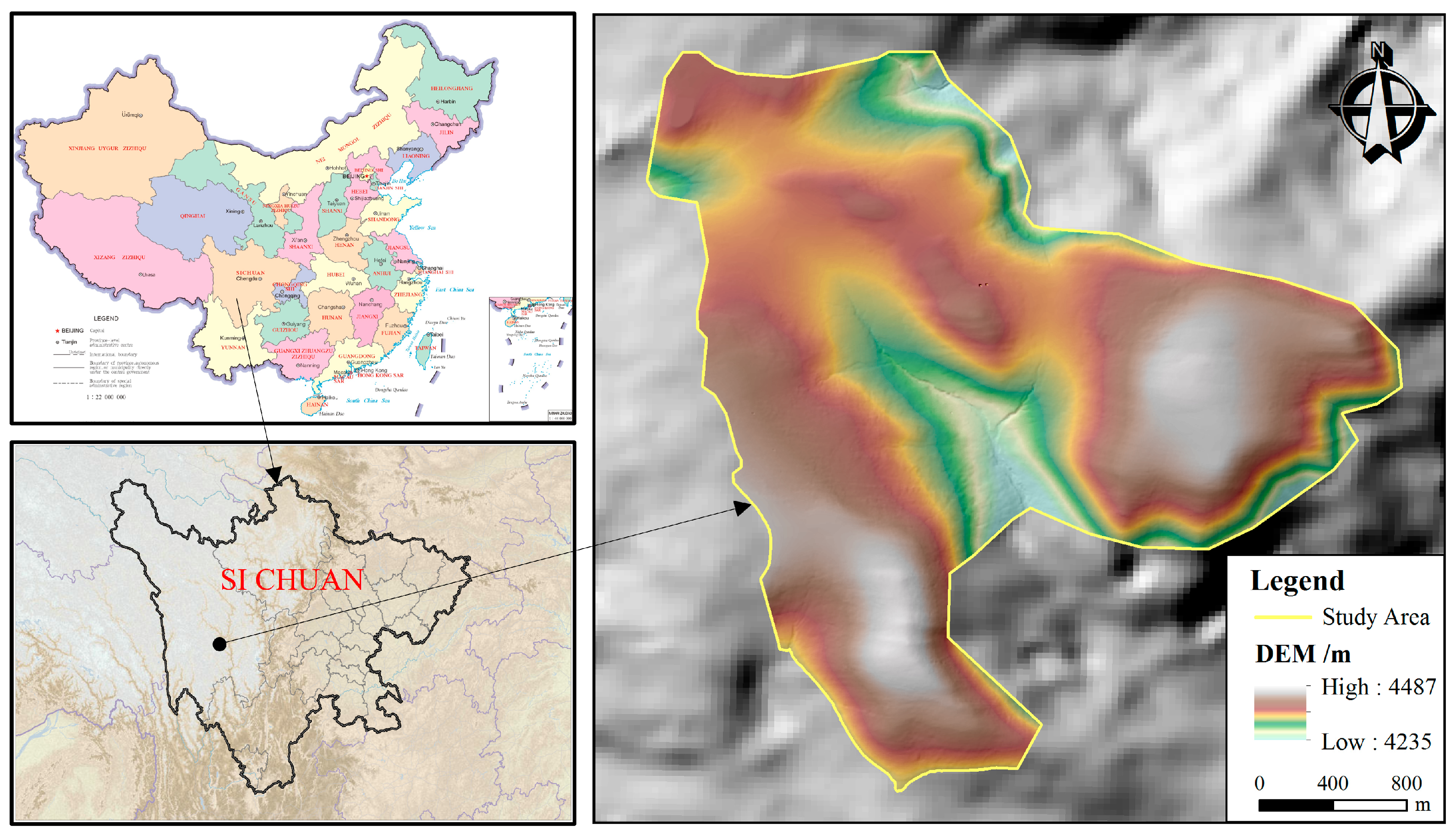

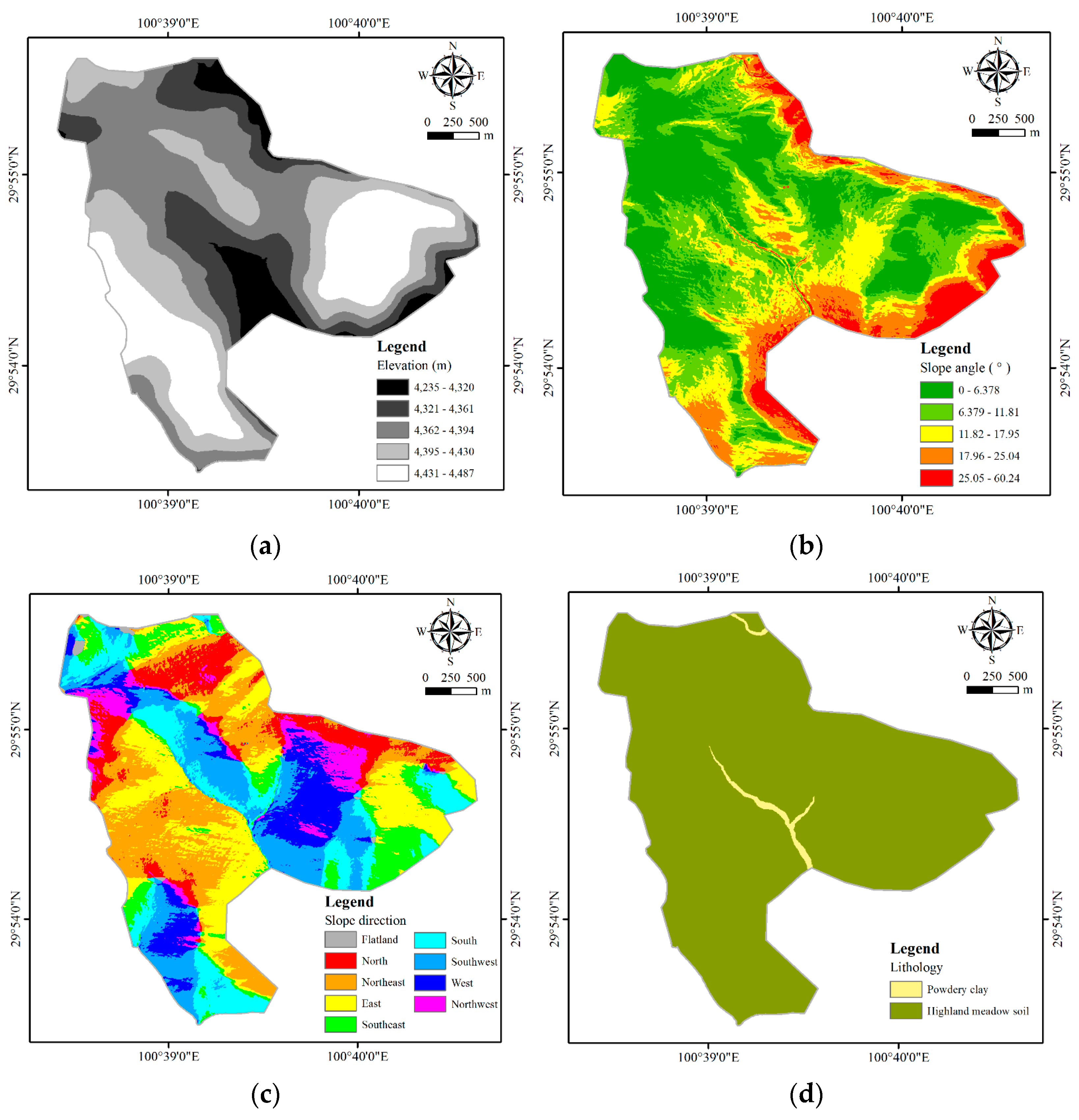

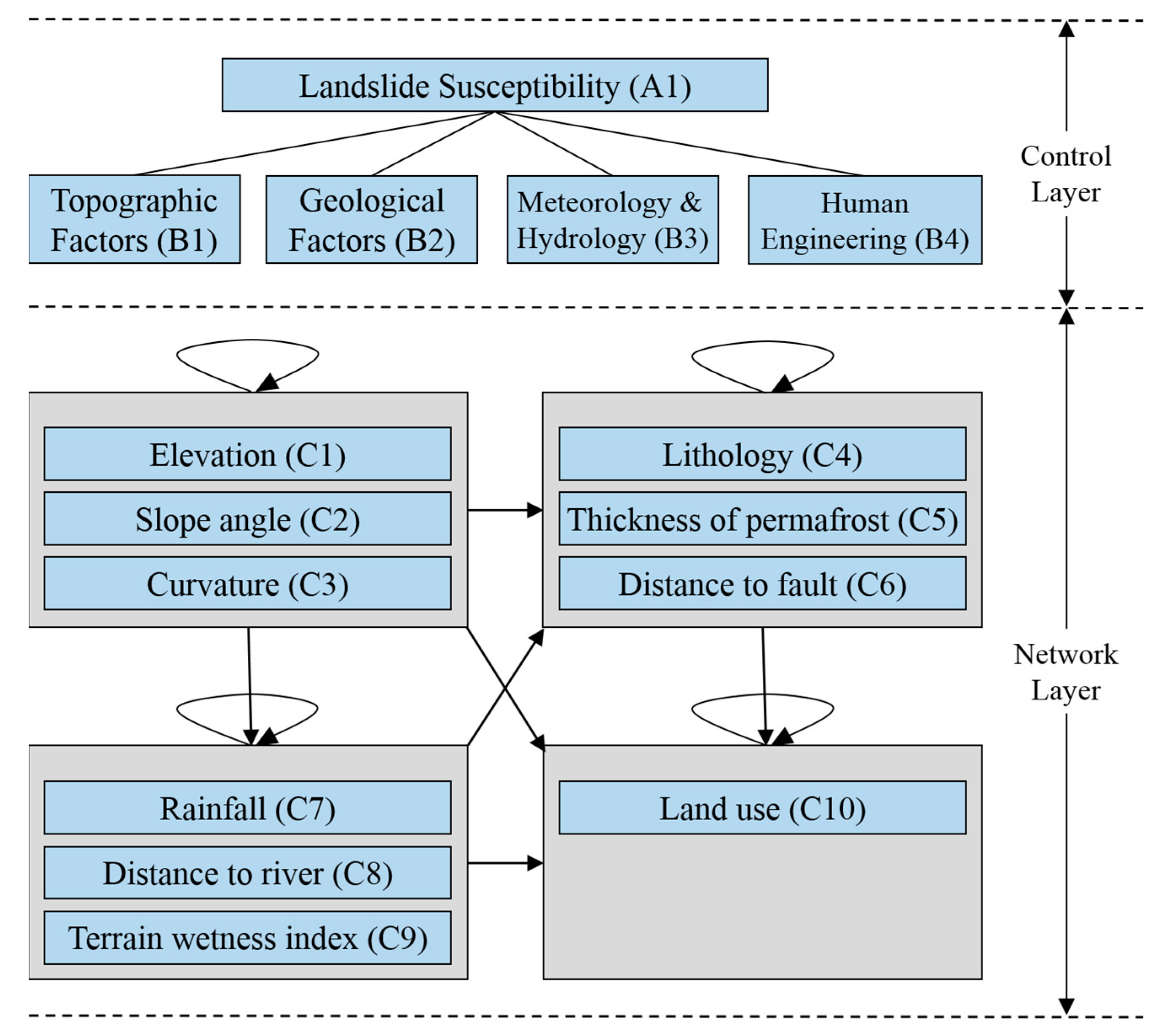

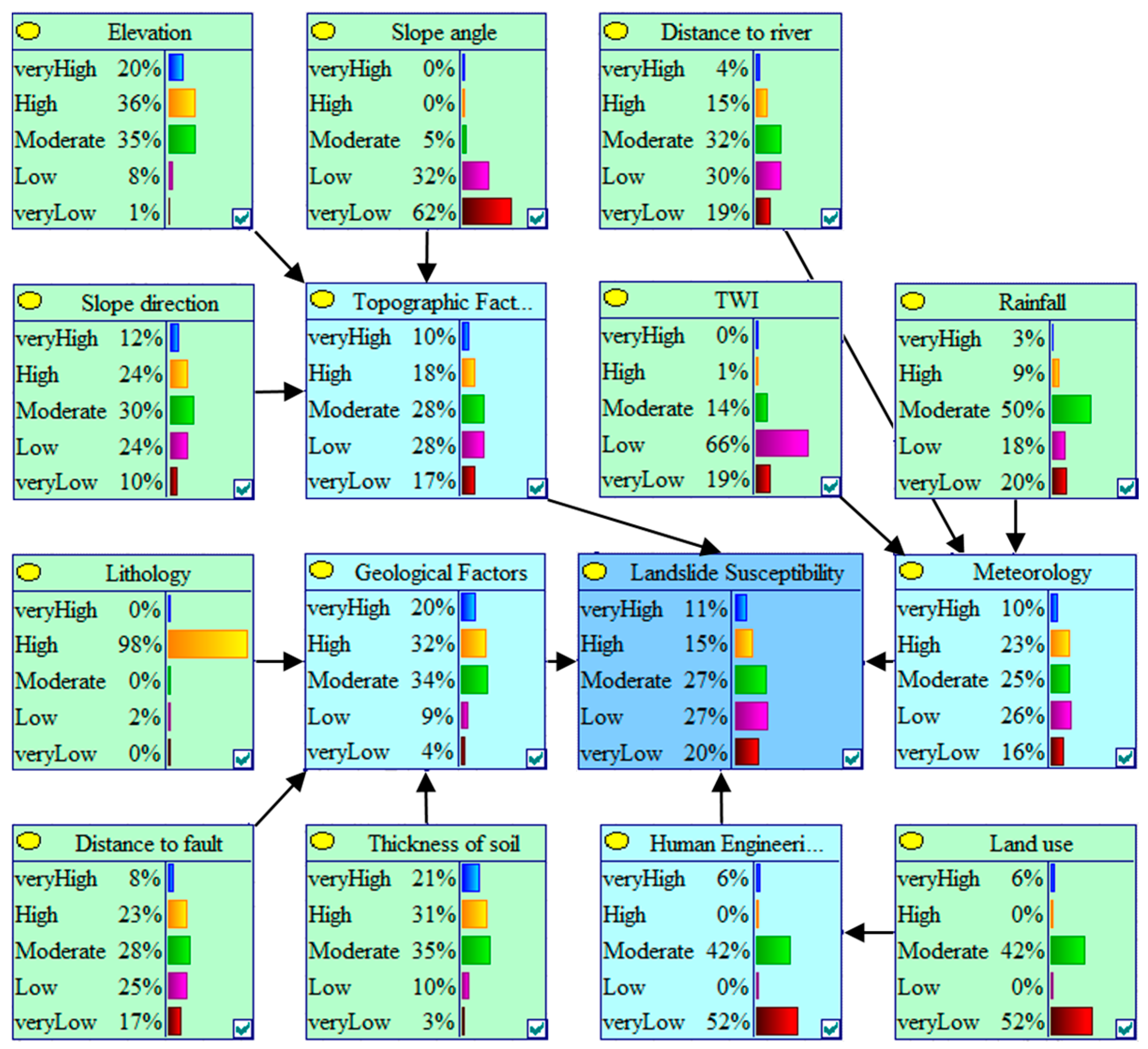






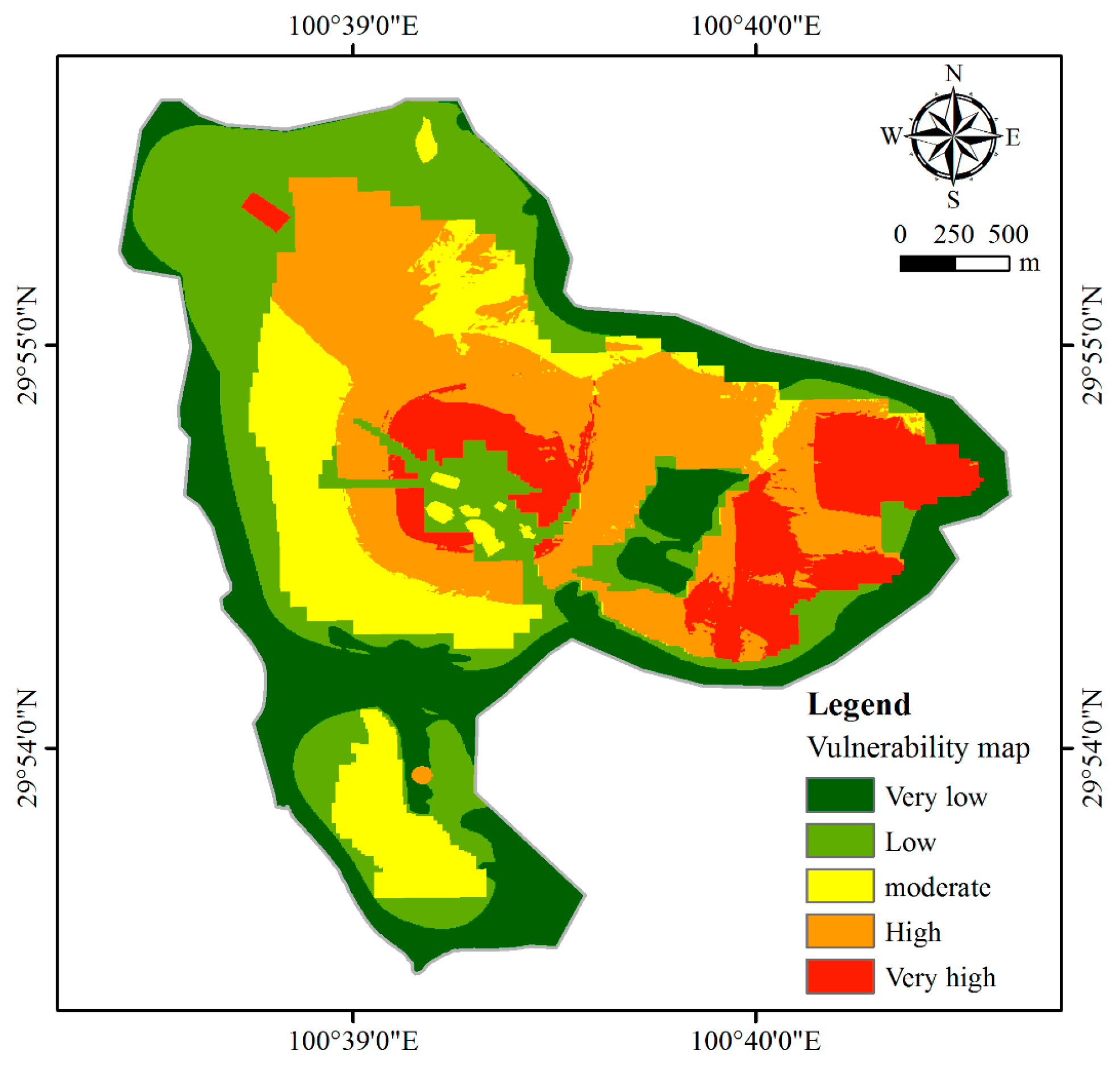
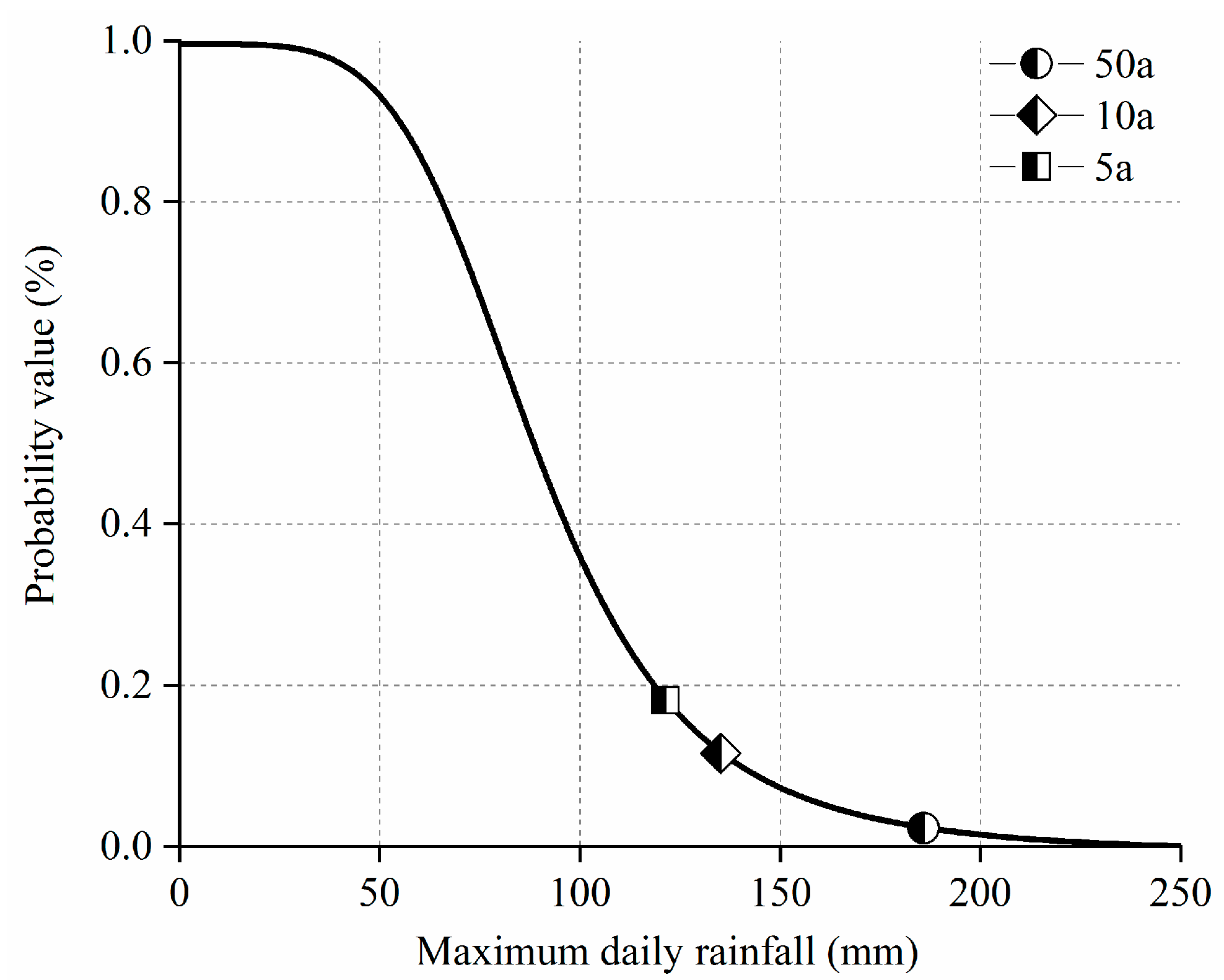

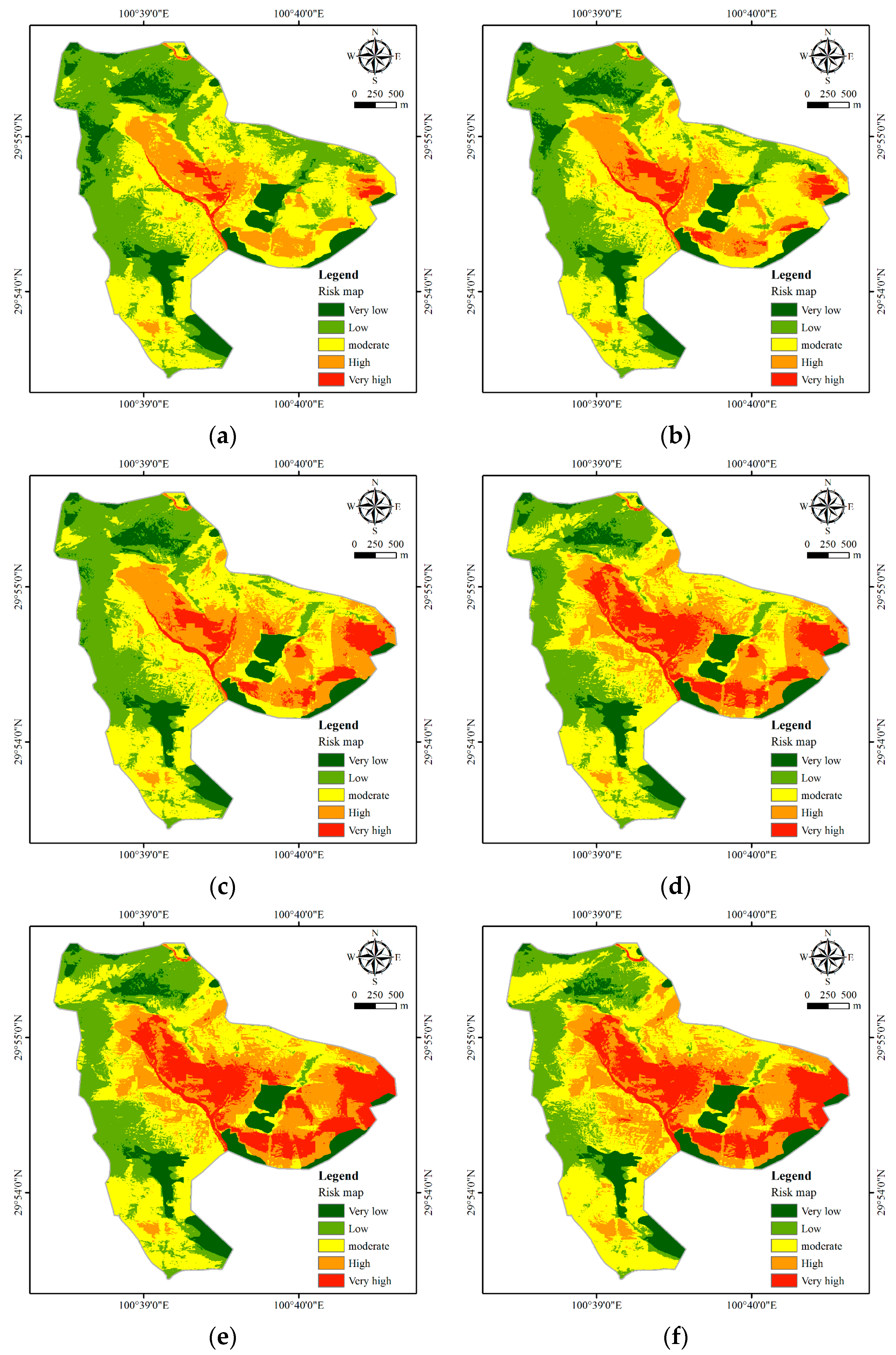
| Number | Condition Factor | Data Source | Variable Type | Method to Get the Value in the Slope Unit |
|---|---|---|---|---|
| C1 | Elevation | Digital Elevation Model (form the topographic contour map, 5 m) | Continues | Average value |
| C2 | Slope angle | Continues | Average value | |
| C3 | Slope direction | Continues | Average value | |
| C4 | Lithology | From the site engineering geological survey report | Categorical | Most frequent value |
| C5 | Thickness of soil | Continues | Minimum value | |
| C6 | Distance to fault | Geological survey map (1:50,000 scale) | Continues | Minimum value |
| C7 | Rainfall | Sichuan Meteorological Bureau | Continues | Average value |
| C8 | TWI | Digital Elevation Model | Continues | Average value |
| C9 | Distance to river | Google image (6 February 2021 date) | Continues | Average value |
| C10 | Land use | From the on-site mapping | Categorical | Most frequent value |
| Criterion Layer | Criterion Layer Weight W1 | Network Layer | Network Layer Weight W2 | Comprehensive Weight W3 = W1 × W2 |
|---|---|---|---|---|
| B1 | 0.414 | C1 | 0.128 | 0.053 |
| C2 | 0.596 | 0.247 | ||
| C3 | 0.276 | 0.114 | ||
| B2 | 0.320 | C4 | 0.536 | 0.172 |
| C5 | 0.357 | 0.114 | ||
| C6 | 0.107 | 0.034 | ||
| B3 | 0.107 | C7 | 0.389 | 0.042 |
| C8 | 0.304 | 0.032 | ||
| C9 | 0.307 | 0.033 | ||
| B4 | 0.159 | C10 | 1.000 | 0.159 |
| Slope Direction | South and Flatland | Southeast and Southwest | East and West | Northeast and Northwest | Northwest |
|---|---|---|---|---|---|
| Value | 9.0 | 6.0 | 5.0 | 2.0 | 1.0 |
| Pairwise Comparison Matrix | ||||
|---|---|---|---|---|
| Criterion and Index Layers | [1] | [2] | [3] | Weights |
| Criterion layer | ||||
| [1] Population vulnerability (B1) | 1 | 1/2 | 1 | 0.234 |
| [2] Economic vulnerability (B2) | 2 | 1 | 2 | 0.561 |
| [3] Material vulnerability (B3) | 1 | 1/2 | 1 | 0.205 |
| = 3.0000, CR = 0.0001 | ||||
| Index layer | ||||
| Economic vulnerability (B2) | ||||
| [1] construction prices (C2) | 1 | 1/3 | 1/2 | 0.286 |
| [2] power generation loss (C3) | 3 | 1 | 2 | 0.514 |
| [3] environmental treatment cost (C4) | 2 | 1/2 | 1 | 0.200 |
| = 3.0055, CR = 0.0028 | ||||
| Criterion Layer | Criterion Layer Weight W1 | Index Layer | Index layer Weight W2 | Comprehensive Weight W3 = W1 × W2 |
|---|---|---|---|---|
| B1 | 0.234 | C1 | 1.000 | 0.234 |
| B2 | 0.561 | C2 | 0.286 | 0.161 |
| C3 | 0.514 | 0.288 | ||
| C4 | 0.200 | 0.112 | ||
| B3 | 0.205 | C5 | 1.000 | 0.205 |
| Grades | A1 | A2 | A3 | A4 | A5 |
|---|---|---|---|---|---|
| Probability of landslide P | ≤10% | 10~30% | 30~50% | 50~80% | ≥80% |
| Intensity of rainfall I (mm/d) | 1.52 | 2.28 | 55.0 | 80.8 | 189.7 |
| Cumulative rainfall E (mm) | 71.29 | 107.17 | 257.84 | 378.21 | 889.44 |
| Grade | Validation Index | Ten-Fold Cross-Validation | Mean | Standard Deviation | |||||||||
|---|---|---|---|---|---|---|---|---|---|---|---|---|---|
| K = 1 | K = 2 | K = 3 | K = 4 | K = 5 | K = 6 | K = 7 | K = 8 | K = 9 | K = 10 | ||||
| Very high | ACC | 0.990 | 0.971 | 0.987 | 0.959 | 0.956 | 0.984 | 0.984 | 0.984 | 0.993 | 0.981 | 0.979 | 0.012 |
| AUC | 0.977 | 0.975 | 0.976 | 0.973 | 0.980 | 0.976 | 0.976 | 0.973 | 0.979 | 0.972 | 0.976 | 0.002 | |
| High | ACC | 0.793 | 0.807 | 0.828 | 0.795 | 0.789 | 0.771 | 0.795 | 0.780 | 0.829 | 0.789 | 0.798 | 0.018 |
| AUC | 0.929 | 0.954 | 0.933 | 0.939 | 0.934 | 0.945 | 0.930 | 0.931 | 0.948 | 0.952 | 0.940 | 0.009 | |
| Moderate | ACC | 0.800 | 0.809 | 0.779 | 0.780 | 0.806 | 0.742 | 0.775 | 0.785 | 0.759 | 0.730 | 0.777 | 0.025 |
| AUC | 0.892 | 0.917 | 0.922 | 0.896 | 0.891 | 0.905 | 0.874 | 0.903 | 0.915 | 0.930 | 0.905 | 0.016 | |
| Low | ACC | 0.744 | 0.714 | 0.727 | 0.712 | 0.704 | 0.760 | 0.719 | 0.701 | 0.726 | 0.709 | 0.722 | 0.018 |
| AUC | 0.896 | 0.896 | 0.871 | 0.874 | 0.889 | 0.887 | 0.877 | 0.885 | 0.898 | 0.877 | 0.885 | 0.009 | |
| Very low | ACC | 0.755 | 0.789 | 0.792 | 0.803 | 0.804 | 0.795 | 0.770 | 0.789 | 0.796 | 0.802 | 0.790 | 0.015 |
| AUC | 0.946 | 0.946 | 0.934 | 0.948 | 0.935 | 0.930 | 0.944 | 0.933 | 0.950 | 0.938 | 0.940 | 0.007 | |
| Grade | 0 d | 1 d | 2 d | 3 d | 4 d | 5 d | ||||||
|---|---|---|---|---|---|---|---|---|---|---|---|---|
| Area | Scale | Area | Scale | Area | Scale | Area | Scale | Area | Scale | Area | Scale | |
| Very low | 0.92 | 12.84 | 0.86 | 11.90 | 0.79 | 11.05 | 0.74 | 10.25 | 0.73 | 10.13 | 0.66 | 9.23 |
| Low | 2.44 | 33.94 | 2.15 | 29.97 | 2.07 | 28.75 | 1.69 | 23.58 | 1.64 | 22.81 | 1.31 | 18.27 |
| Moderate | 2.68 | 37.32 | 2.70 | 37.59 | 2.41 | 33.58 | 2.35 | 32.75 | 2.16 | 30.03 | 2.33 | 32.44 |
| High | 0.97 | 13.50 | 1.14 | 15.90 | 1.44 | 19.98 | 1.51 | 21.01 | 1.55 | 21.61 | 1.76 | 24.48 |
| Very high | 0.17 | 2.39 | 0.33 | 4.64 | 0.48 | 6.65 | 0.89 | 12.41 | 1.11 | 15.41 | 1.12 | 15.58 |
Disclaimer/Publisher’s Note: The statements, opinions and data contained in all publications are solely those of the individual author(s) and contributor(s) and not of MDPI and/or the editor(s). MDPI and/or the editor(s) disclaim responsibility for any injury to people or property resulting from any ideas, methods, instructions or products referred to in the content. |
© 2023 by the authors. Licensee MDPI, Basel, Switzerland. This article is an open access article distributed under the terms and conditions of the Creative Commons Attribution (CC BY) license (https://creativecommons.org/licenses/by/4.0/).
Share and Cite
Li, R.; Huang, S.; Dou, H. Dynamic Risk Assessment of Landslide Hazard for Large-Scale Photovoltaic Power Plants under Extreme Rainfall Conditions. Water 2023, 15, 2832. https://doi.org/10.3390/w15152832
Li R, Huang S, Dou H. Dynamic Risk Assessment of Landslide Hazard for Large-Scale Photovoltaic Power Plants under Extreme Rainfall Conditions. Water. 2023; 15(15):2832. https://doi.org/10.3390/w15152832
Chicago/Turabian StyleLi, Ru, Siyi Huang, and Hongqiang Dou. 2023. "Dynamic Risk Assessment of Landslide Hazard for Large-Scale Photovoltaic Power Plants under Extreme Rainfall Conditions" Water 15, no. 15: 2832. https://doi.org/10.3390/w15152832





